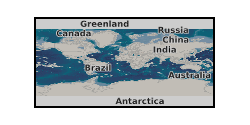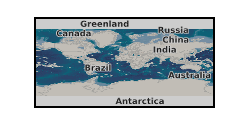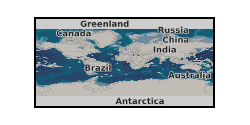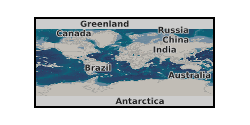service-view
Type of resources
Available actions
Keywords
Contact for the resource
Provided by
Years
Formats
Update frequencies
Service types
Resolution
-

This Web service provides layers which show data relating to offshore survey activities undertaken by the British Geological Survey (BGS) and its predecessors. The layers are polygon, line and point layers which indicate the spatial areas of survey activities. The survey overview layer shows the location and basic information for coastal and marine surveys. It includes information about the survey, including the types of equipment deployed during the survey. For some surveys, a zip file of additional data can be downloaded using the URL link provided where available. The geophysical surveys layers show survey lines and shot points along those lines, where applicable. Geophysical surveys include shallow seismic reflection (e.g. airgun, boomer, pinger, sparker and water gun) and sonar (e.g. echo sounder, sidescan sonar and transit sonar). There may be several types of equipment deployed on a single survey line. Survey lines are uniquely named with a survey and line identifier (name or number). For example, 1985/6#16 is line 16 of survey 1985/6. The lines layer includes seismic reflection (sub seabed imaging which provides information about structures below the seabed) and sonar (seabed imaging which provides information about the roughness of the seabed or simple bathymetric data). Links to scanned images of geophysical records are provided (where available) for openly available survey lines where terms of use are known. The backscatter layer shows the location and basic information for bathymetric surveys containing backscatter data. A zip file of the backscatter image files for the survey can be downloaded using the URL link provided. Note that there can be more than one polygon per survey and these will link to the same zip file for the entire survey. The majority of the data were collected and processed for the Maritime and Coastguard Agency (MCA) under the Civil Hydrography Programme. To download the related bathymetry data go to the Admiralty Marine Data Portal (https://datahub.admiralty.co.uk/portal/apps/sites/#/marine-data-portal). The oil and gas industry site surveys layer shows the geographic location of oil and gas industry site surveys. The metadata for these surveys were collated via the BGS MEDIN Data Archive Centre (DAC). BGS do not hold the data. For further information contact the custodian of the data. For more information, contact BGS Marine Enquiries (offshoredata@bgs.ac.uk).
-

High Resolution, Airborne Magnetic, Radiometric, VLF Survey over north Midlands of GB. Survey flying for the collaborative BGS and World Geoscience Corporation Ltd (WGC) high resolution geophysical and environmental survey was completed in early September 1998. The data comprise multi-channel gamma ray spectrometer, magnetometer and dual frequency VLF-EM. Flight line spacing was 400 m with tie lines at 1200 m and the total area surveyed is some 14 000 km2. Flight-line orientations are W–E over the western survey area, SW–NE over the eastern area. Ground clearance was maintained at 90 m in rural areas, increasing to about 240 m in built-up zones.
-

Data from the British Geological Survey's GeoIndex Offshore (cultural data) theme are made available for viewing here. GeoIndex is a website that allows users to search for information about BGS data collections covering the UK and other areas world wide. Access is free, the interface is easy to use, and it has been developed to enable users to check coverage of different types of data and find out some background information about the data. More detailed information can be obtained by further enquiry via the web site: www.bgs.ac.uk/geoindex.
-

This Web service provides the Indicative Atlas of Radon Potential for Great Britain dataset. Every building contains radon (Rn) but the levels are usually low. The chances of a higher level depend on the type of ground. The UK Health Security Agency (UKHSA) and the BGS have published a map showing where high levels are more likely. The darker the colour, the greater the chance of a higher level of radon. The chance is less than one home in a hundred in the white areas and greater than one in three in the darkest areas.
-

This Web service provides layers which are part of the BGS Superficial Deposits Thickness Model (SDTM) series of datasets. It currently includes two layers from the STDM 1 km hex grid dataset, which is available under the Open Government Licence. These two layers are symbolised on the mean and maximum values of the BSTM thickness model within the area of each hexagon. In these two layers, note that the data include a generic value of 1 m thickness for any area where superficial material is present, but is unproven by boreholes (shown on the map by a grey colour).
-

This Web service provides layers which show metadata relating to geochemical samples held by the British Geological Survey (BGS). The layers are point layers which indicate the spatial locations samples were taken from. Geochemical samples have been collected, analysed and stored in the BGS Geochemistry Database from different projects. The two most significant contributors to the database are the Geochemical Baseline Survey of the Environment (G-BASE) project and the Mineral Reconnaissance Programme (MRP). Each project took a variety of different sample types, including stream water, stream sediment, shallow soil and deep soil, and one layer is provided for each type of sample. The sample metadata provided include: sample name; sample type; the Regional Geochemical Atlas area (for G-BASE samples only) and a comma-separated list of available analytes. In many cases, samples are retained in the National Geoscience Data Centre (NGDC) at BGS Keyworth. For more information about obtaining samples or the results of their geochemical analyses, contact BGS Enquiries (enquiries@bgs.ac.uk).
-

The BGS has been commissioned by Defra to provide guidance on what are 'normal' levels of contaminant concentrations in English soils in support of the revision of the Part 2A Contaminated Land Statutory Guidance. The domain polygons and other data produced by this work are served as WMS here.
-

Data from the British Geological Survey's GeoIndex Offshore theme are made available for viewing here. GeoIndex is a website that allows users to search for information about BGS data collections covering the UK and other areas world wide. Access is free, the interface is easy to use, and it has been developed to enable users to check coverage of different types of data and find out some background information about the data. More detailed information can be obtained by further enquiry via the web site: www.bgs.ac.uk/geoindex.
-

This Web service provides layers containing data from the BGS Geology 625k (DiGMapGB-625) dataset. BGS Geology 625k provides small-scale (1:625 000 scale) bedrock and superficial geology mapping for use at a regional and national level. The bedrock and superficial data are symbolised by lithology and lithostratigraphy, and a bedrock age layer is also provided for the bedrock layer. Additional linear features (faults) and dykes layers are provided for use in conjunction with the bedrock layer. For more information about the digital maps available from the British Geological Survey, please visit https://www.bgs.ac.uk/geological-data/. The data are provided through this service for view and download under the Open Government Licence.
-

BGS offshore marine products are made available to view via this web map service. The 1:250 000 scale offshore geological maps in the UTM series (Universal Transverse Mercator projection) are available digitally as two themes: bedrock geology (DigRock250) and sea-bed sediments (DigSBS250). Marine Hard Substrate Dataset (DiGHardSubstrate250k) is also made available via this service.
 NERC Data Catalogue Service
NERC Data Catalogue Service